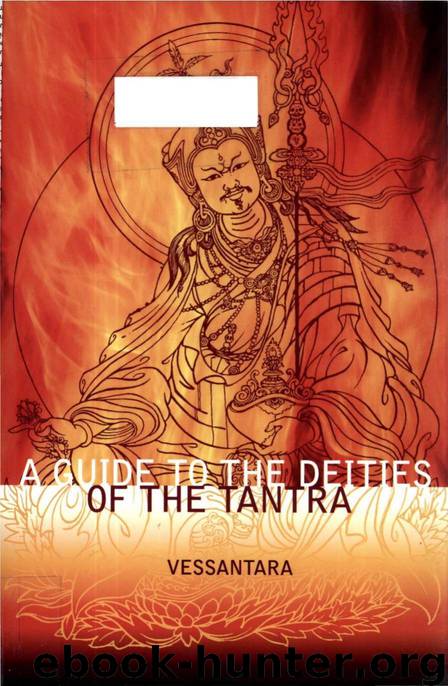A Guide to the Deities of the Tantra (Meeting the Buddhas) (2008) by Vessantara

Author:Vessantara
Language: eng
Format: mobi, epub, azw3
Published: 0101-01-01T00:00:00+00:00
Plate One Heruka Cakrasamvara
Plate Two Vajrabhairava
Plate Three Kalacakra
Plate Four Vajravarahi
Plate Five Vajrayogim in a form also known as Sarvabuddhadakini
Plate Six Six-Armed Mahakala
Plate Seven Sridevi
Plate Eight Sakyamuni Refuge Assembly from the Gelukpa tradition
The Oath-Bound Deities
According to tradition, the Kalacakra Tantra was proclaimed by the
Buddha, himself appearing in the form of Kalacakra a year after his En-
lightenment.55 He taught the Tantra at Dhanyakataka in southern India,
inside a huge stupa, at the request of King Sucandra. Sucandra was king
of Shambhala - a legendary country to the north-east of India. T h e king
returned to Shambhala, built a three-dimensional mandala of Kalacakra,
and made Tantric Buddhism based on the Kalacakra system the state
religion.
T h e Kalacakra teachings were propagated in Shambala by a line of kings.
T h e eighth, Manjusrikirti, initiated many people into the Tantra, and
also composed a short text - the 'Condensed Kalacakra Tantra' - which is
what is now generally known as the Kalacakra Tantra. In consequence he
became known as Kulika (one w h o bears the lineage). According to trad-
ition, the Kalacakra teachings are still being propagated in Shambala by
the Kulika kings. An Indian master from Orissa called Cilupa is said to
have travelled to Shambala and returned with Kalacakra teachings, which
were subsequently passed on to Naropa and then to Atisa. T h e fact that
there is no trace of the Tantra in India before Cilupa has led some schol-
ars to suggest that the Tantra originated somewhere in central Asia.
T h e Kalacakra teachings came to Tibet with Atisa in 1026. Their intro-
duction into Tibet led to a new system of measuring time in sixty-year
periods. Five elements, fire, earth, water, wood, and metal, were added to
the twelve-year system by which each year is attributed to one of the
signs of the zodiac.
The Kalacakra system was studied by all schools of Tibetan Buddhism. It
was propagated by the great Sakyapa lamas Sakya Pandita and Phakpa.
Tsongkhapa, the founder of the Geluk order, wrote several short works
on it, and his two main disciples both wrote extensive commentaries.
To achieve a clear visualization of the most complex mandala of Kala-
cakra would be a meditative tour deforce. O n e would have to become, in
meditation, a four-faced male deity with consort, standing on the figures
of Kamadeva (the Indian god of love) and Rudra. T w o goddesses, the
consorts of the subjugated gods, hold on to Kalacakra's heels, their heads
bowed.
8 9
A Guide to the Deities of the Tantra
T h e yab is blue, and has six shoulders, twelve upper arms, and twenty-
four lower arms. T h e lower arms are arranged in three sets of four on
each side, each set of a different colour. T h e uppermost set on each side is
white, the middle red, the lower blue. Each of his arms holds a symbolic
implement, such as a sword, a wheel, or an axe. Even his fingers are of
different colours.
As Kalacakra one would embrace the consort Visvamata (mother of all).
She is yellow in colour, with four faces and eight arms. She holds a
curved knife, an iron hook, a damaru, and a rosary in her right hands, and
a skull, a noose, a white lotus, and a jewel in her left.
Download
A Guide to the Deities of the Tantra (Meeting the Buddhas) (2008) by Vessantara.epub
A Guide to the Deities of the Tantra (Meeting the Buddhas) (2008) by Vessantara.azw3
This site does not store any files on its server. We only index and link to content provided by other sites. Please contact the content providers to delete copyright contents if any and email us, we'll remove relevant links or contents immediately.
| Buddhism | Christianity |
| Ethnic & Tribal | General |
| Hinduism | Islam |
| Judaism | New Age, Mythology & Occult |
| Religion, Politics & State |
Cecilia; Or, Memoirs of an Heiress — Volume 1 by Fanny Burney(31341)
Cecilia; Or, Memoirs of an Heiress — Volume 3 by Fanny Burney(30938)
Cecilia; Or, Memoirs of an Heiress — Volume 2 by Fanny Burney(30897)
The Secret History by Donna Tartt(16644)
Sapiens: A Brief History of Humankind by Yuval Noah Harari(13067)
Leonardo da Vinci by Walter Isaacson(11913)
The Radium Girls by Kate Moore(10914)
Sapiens by Yuval Noah Harari(4546)
The Wind in My Hair by Masih Alinejad(4427)
How Democracies Die by Steven Levitsky & Daniel Ziblatt(4407)
Homo Deus: A Brief History of Tomorrow by Yuval Noah Harari(4287)
Endurance: Shackleton's Incredible Voyage by Alfred Lansing(3852)
The Silk Roads by Peter Frankopan(3771)
Man's Search for Meaning by Viktor Frankl(3645)
Millionaire: The Philanderer, Gambler, and Duelist Who Invented Modern Finance by Janet Gleeson(3574)
The Rape of Nanking by Iris Chang(3522)
Hitler in Los Angeles by Steven J. Ross(3444)
The Motorcycle Diaries by Ernesto Che Guevara(3341)
Joan of Arc by Mary Gordon(3263)
